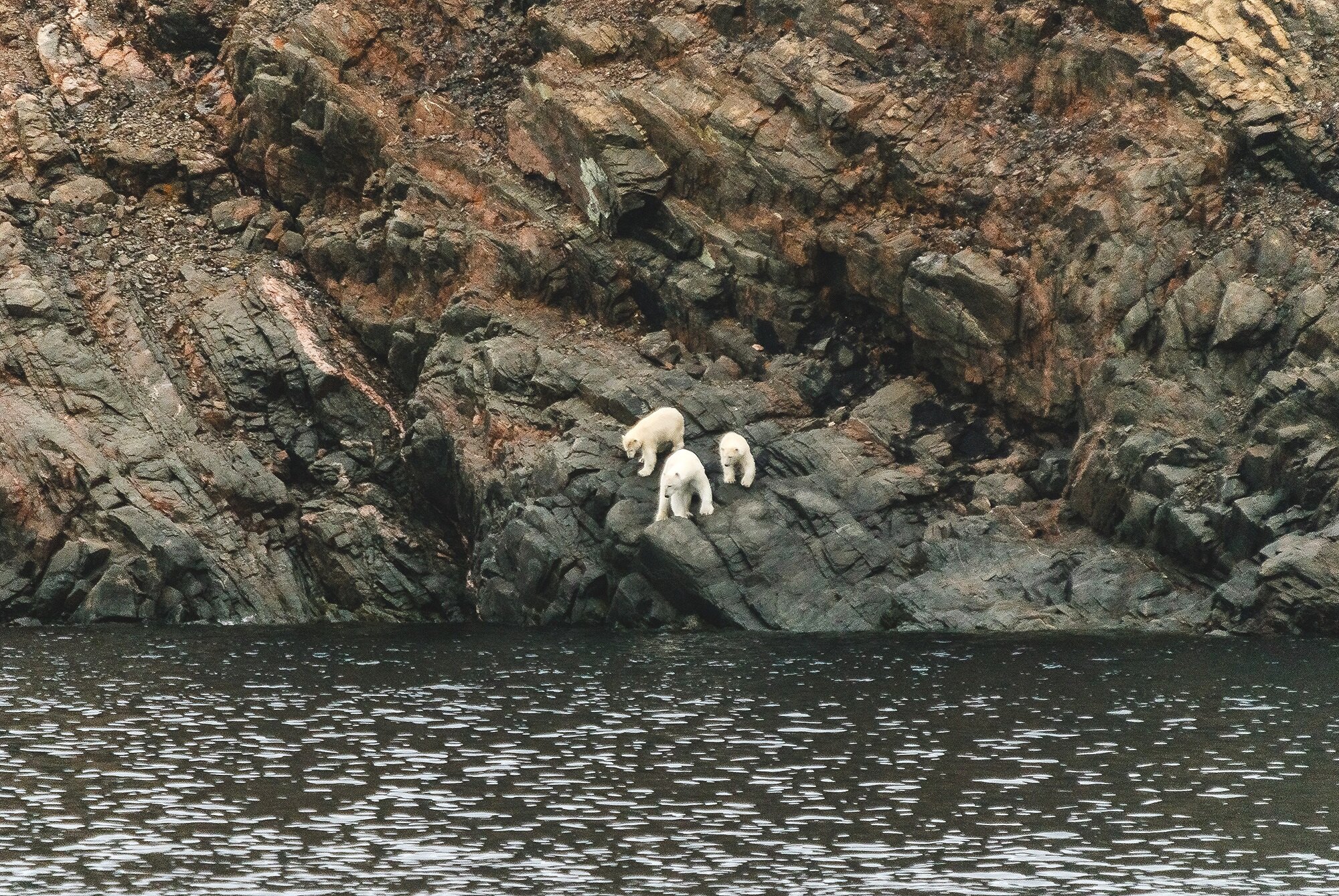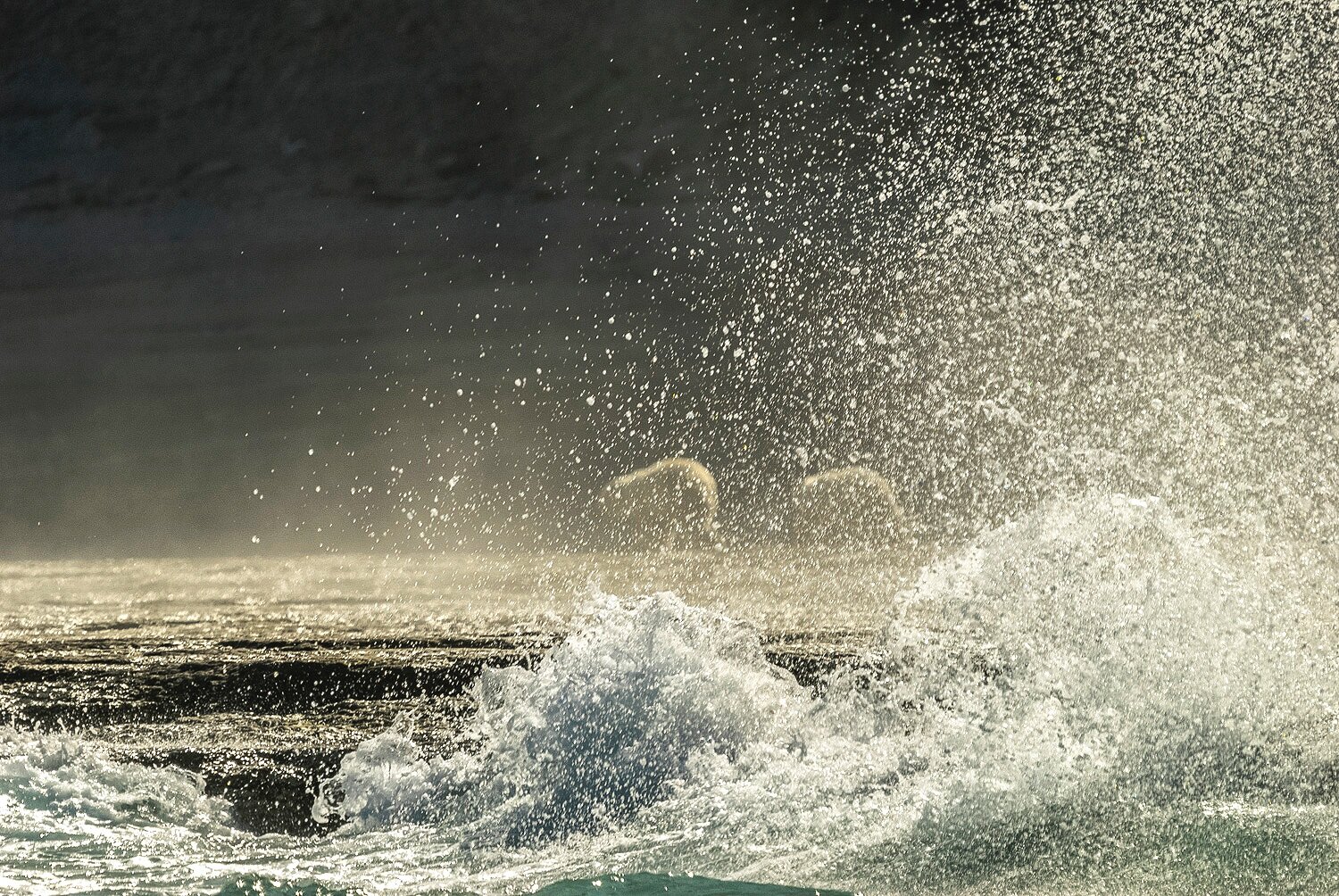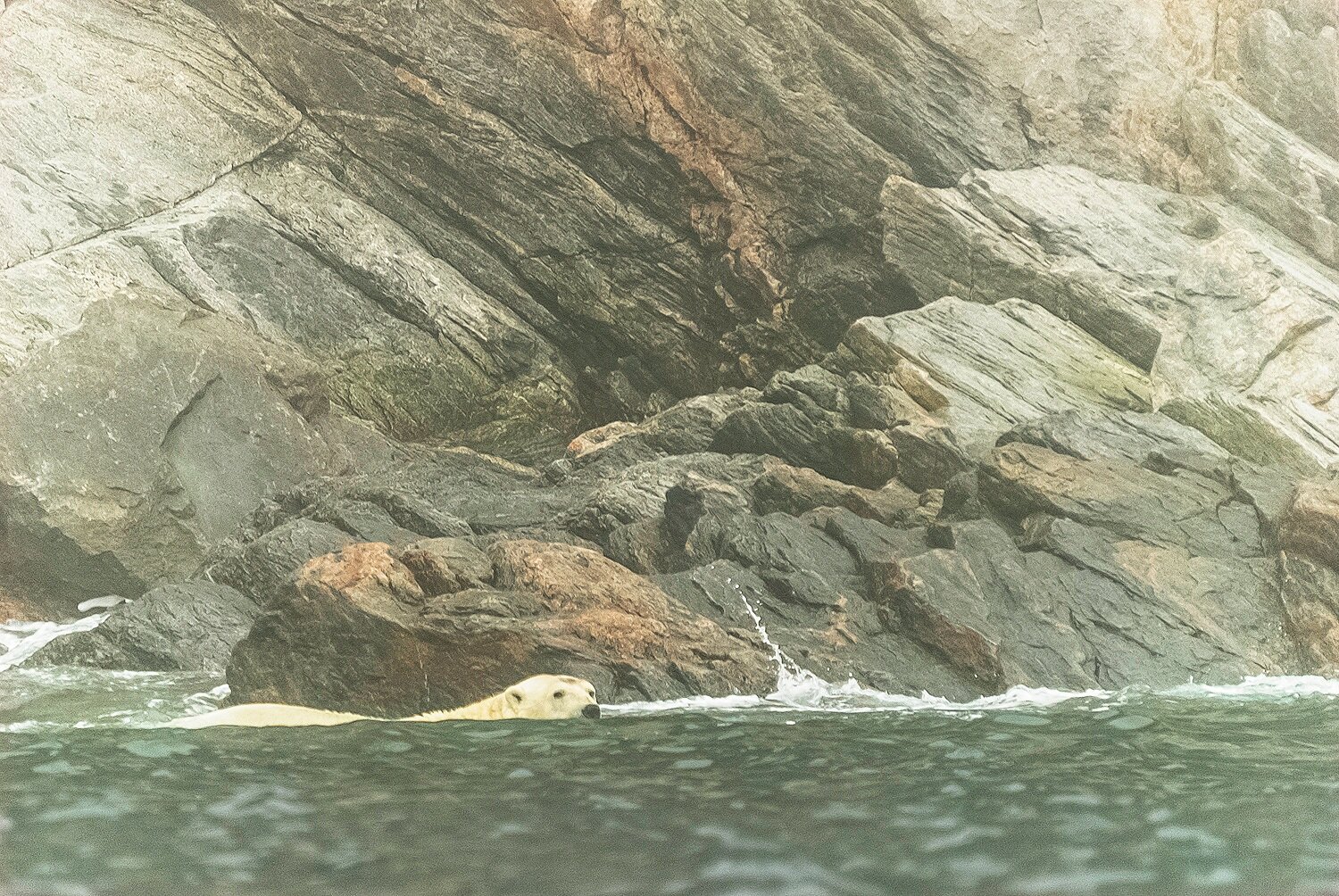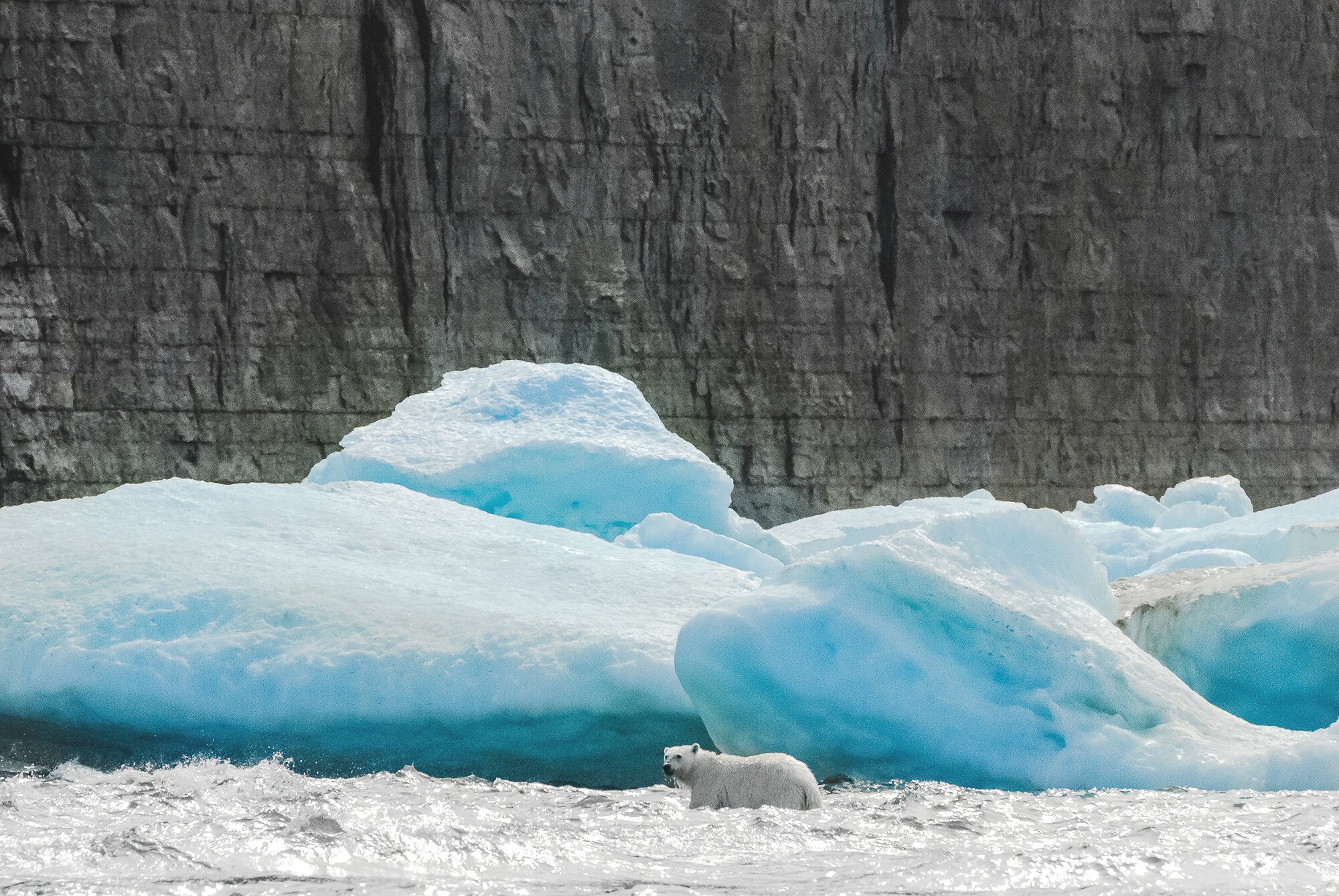
A the Edge of an Ice-Free Sea
Photography depicting the relationship between polar bears and sea ice, including intimate portraits of individual animals, and never before seen photographs of how polar bears are trying to adapt to climate change.

No Ice, Nowhere to Go
Bellot Strait, Nunavut, Canadian Arctic

Stranded Polar Bear and Waterfall
Akpatok Island, Nunavut, Canadian Arctic
A polar bear walks the beach of Akpatok Island in Ungava Bay, where a magnificent 800 foot waterfall pours straight down from the limestone cliffs above. At their apex the cliffs reach a height of 1,000 feet. These cliffs host a nesting colony of hundreds of thousands of birds, and the bears wander back and forth beneath the cliffs, searching for eggs and fledglings fallen from the heights. If you look closely at this photograph, about halfway up the frame near the right edge you will see a small dark arch dug into the green vegetation. This is a summer den where females and cubs can rest in the cool shade.

The New Normal
Akpatok Island, Nunavut, Canadian Arctic
A mother polar bear and her cub stroll past ocean waves crashing against the shoreline of Akpatok Island. As the ice diminishes, the bears must spend increasing amounts of time on shore waiting for the sea to freeze over.

The Face of Climate Change
Lower Savage Islands, Nunavut, Canadian Arctic
A starving, exhausted polar bear watches a seal rise just offshore and out of reach. I could feel the bear's resignation as there was nothing he could do. He was trapped, and freeze-up was still weeks away. A few moments later the bear closed his eyes and did I did not see him reopen them.

Bear Waiting at the Edge of the Sea
Akpatok Island, Nunavut, Canadian Arctic
A stranded polar bear stands staring out to sea from the edge of the island where he will spend the summer until solid ice forms in autumn. The warming climate and thinning ice pose a challenge to the bears, who must endure a significantly longer ice-free season than they did just a few decades ago. For some bears this means an additional three weeks of fasting until they can get out upon the ice to hunt seals.

Polar Bear Family at Sea
Ungava Bay, Nunavut, Canadian Arctic
The polar bear is the iconic symbol of the arctic, and perhaps nothing symbolizes the great changes that are occurring at the top of the world more than an image of a polar bear family at sea, dozens of miles from shore, without an ice floe in sight. When I came across this family of bears in the middle of Ungava Bay I wondered if the cubs would survive.

Polar Bear Cubs at Sea
Ungava Bay, Nunavut, Canadian Arctic
Two young polar bear cubs hold onto their mother's back during a long open ocean swim. Polar bears are very strong swimmers. They use their large front paws, which are slightly webbed, to paddle; and they use their rear paws as rudders to maintain course. Polar bears have been seen swimming hundreds of miles from land, although they may have traveled portions of those great distances by floating on ice floes.

The Spy Hopper
Ungava Bay, Nunavut, Canadian Arctic
I was traveling in a small skiff off the coast of a remote island in the Canadian Arctic when I saw what looked like an ice chunk rise up out of the water. It was a polar bear rising above the surface like a spy-hopping killer whale, taking a quick look around before swimming to shore.
In the United States, polar bears (ursus maritimus) are classified as a marine mammals because they spend most of their lives at sea on the ice, and they are capable of tremendous long-distance swims.

Ursus Maritimus
Davis Strait, Nunavut, Canadian Arctic
Traveling in a small skiff along the coast of an island in the Canadian Arctic on a cold, misty day, I looked to my left and watched as a chunk of ice rose like a submarine from beneath the choppy wavelets. Then, the ice started moving forward and turned into a polar bear, swimming stealthily alongside me right at the surface.

Polar Bear in the Polar Desert
Beechey Island, Nunavut, Canadian Arctic
A stranded polar bear sits on the bleak, barren, lifeless plain of the Polar Desert on Beechey Island in the Canadian High Arctic, just a few yards away from the frozen graves of three 19th century sailors who died here in the winter of 1845. That year the British explorer Sir John Franklin commanded an ill-fated search for the Northwest Passage aboard HMS Erebus and HMS Terror. Franklin chose to overwinter here aboard the ships, which were frozen into the ice of the protected harbor. The following year when the ice went out, the ships sailed away into the unknown. What is known is that no one survived the expedition.

Bear on the Rocks
Monumental Island, Nunavut, Canadian Arctic
A surprised polar bear stranded on Monumental Island in Davis Strait peers down at me as I pass by his resting place in a small skiff just a few yards away. I was circumnavigating this small rocky islet some thirty miles off the coast of Baffin Island when I apparently woke this bear from his nap.
During the ice-free summer, bears save their energy and move as little as possible to keep from overheating as they wait for winter to return.

Stranded Polar Bear at the Shoreline
Akpatok Island, Nunavut, Canadian Arctic

Bear Emerging From the Sea
Davis Strait, Nunavut, Canadian Arctic
A polar bear looks over his shoulder as he emerges from the sea. For thousands of years polar bears have been the dominant marine mammal in the Arctic. However, the loss of sea ice is encouraging killer whales to move north into polar bear habitat where they may compete directly with the bears for seals, and ultimately challenge the bears for domination.

Stranded Polar Bear Beneath Massive Limestone Cliffs
Akpatok Island, Nunavut, Canadian Arctic

Walrus and Stranded Bear
Akpatok Island, Nunavut, Canadian Arctic
A walrus surfaces just offshore of the arctic island where a polar bear is stranded for the ice-free season. Polar bears will prey upon walrus, but due to the walrus' great size and tusks, walrus do not constitute a major part of the bear's diet. Bears will prey upon walrus calves, and they will attempt to take down injured walrus, but direct attacks upon healthy adult walrus are rare.

Foraging
Akpatok Island, Nunavut, Canadian Arctic
Exhibiting behavior adapting to climate change, a polar bear stranded on Akpatok island in the Canadian Arctic stands on hind paws to graze upon a leafy plant called scurvy grass. Polar bears are exceptionally resourceful animals, and they will take advantage of practically any food source.
Scurvy grass was eaten by 19th century sailors suffering from scurvy during long arctic sea voyages. Scurvy is a deficiency disease caused by a lack of fresh food, and the leaves of scurvy grass, rich in vitamins, provide a cure. Just like polar bears, humans still forage for scurvy grass leaves. They have a strong peppery taste similar to watercress, and are frequently used in salads in the far north

Females and Cub Avoid a Predatory Male
Akpatok Island, Nunavut, Canadian Arctic
Two female polar bears and a cub take a wide detour around a male polar bear marching down the beach of Akpatok Island. Many bears in the Ungava Bay area are stranded here during the ice-free season. When they share the same limited space and limited food sources, the females must be extra vigilant guarding the cubs from cannibalistic male bears.

Polar Bear Among The Ice Floes
Akpatok Island, Nunavut, Canadian Arctic

Wounded Bear
Akpatok Island, Nunavut, Canadian Arctic
Traveling along the shoreline of an Arctic island through the fog in a small boat, I came upon a stranded polar bear lying wounded --probably mortally-- on the beach he shares in close quarters during the ice-free season with other bears. Food stress, and competition for food with other bears, probably led to the battle that wounded and most likely killed this bear.

Starving Bear
Lower Savage Islands, Nunavut, Canadian Arctic
Traveling in a small boat, threading my way through a chain of small, barren Arctic islands, I came across a heartbreaking scene. On the beach of one small island I saw a stranded polar bear that was clearly starving and close to death. With freeze-up still a month in the future, this bear was trapped on these rocky outcrops with no way of finding food.

Starving Polar Bear Searching For a Place to Rest
Lower Savage Islands, Nunavut, Canadian Arctic

Starving Bear Spotting a Seal From Shore
Lower Savage Islands, Nunavut, Canadian Arctic

Polar Bear Summering in a Seabird Coloy
Coburg Island, Nunavut, Canadian Arctic
Exhibiting behavior that never been documented before, a stranded polar bear spends the ice-free season feeding upon hundreds of thousands of nesting seabirds and their eggs on Coburg Island in the Canadian High Arctic. This rare sighting demonstrates the intelligence of the polar bears and their ability to adapt to changing environmental conditions. Not all polar bears will survive the dramatic changes occurring in the Arctic, but some - like this one -will.

Adapting to Climate Change
Coburg Island, Nunavut, Canadian Arctic

When Seals Are No Longer on the Menu...
Coburg Island, Nunavut, Canadian Arctic

...Then Eat Seabirds
Coburg Island, Nunavut, Canadian Arctic

This Bear Will Make It
Coburg Island, Nunavut, Canadian Arctic



























